Introduction
One of the most renowned geological monuments in the Aegean area, the Lesvos Petrified Forest is located on the western peninsula of Lesvos Island, north-eastern Aegean, Greece. Lesvos Island is the third largest Greek island, covering an area of 1630 km2. The main concentrations of petrified trunks, comprising the renowned Petrified Forest, appear thanks to natural erosion of pyroclastic rocks in the western peninsula of Lesvos over an area of 15,000 ha. Large petrified trees are found in many other locations in the lower Miocene volcanic formations, covering almost two-thirds of Lesvos Island, as well as in the marine area along its western coast. The glory of the standing fossilized trunks, the brilliance and vivacity of their colours, and the wild beauty of the volcanic landscape have attracted the interest of people since antiquity. A large number of standing petrified trunks with their root systems intact and in full development provides proof that these trees were petrified in their original growth positions.
The first reference to the fossils of Lesvos is found in Theophrastus from Eresos (c. 371 – c. 287 BC) the successor to Aristotle in the Peripatetic school, in his surviving work De Lapidibus “about rocks”. The first scientific reference to the species of the petrified trees dates from 1844, when the Austrian paleobotanist Franz Unger (1800–1870) described the fossil trees of Lesvos, although he was not sure about their age. The samples studied by Unger were transferred to Vienna by the Austrian diplomat Anton Prokesh-Osten, who refers to the existence of fossil tree trunks at the harbor of Sigri (Prokesh-Osten 1852). Since then, the Petrified Forest of Lesvos has excited the interest of many travellers and scholars. The French geologist Luis De Launay (1898) marveled at the fossilized trees of Lesvos and Berger (1953) refers to the fossil trunks in Lesvos.
The historic locality of the Petrified Forest lies at Bali Alonia, known as Kyria Apolithomeni (= ‘petrified lady’), since the 18th century because of the large number of fossilized tree trunks. The area was expropriated by the Greek State in 1966 to protect and enhance the fossilized trees. Recognizing the major environmental, geological and paleontological value of the Petrified Forest, the Greek State has declared it a protected Natural Monument (Presidential Decree 443/85). It is protected according to the Forest Police Order 1/1996 of the Forests Directorate of Lesvos. The Museum of Natural History of the Petrified Forest of Lesvos was founded in 1994 (L. 2260/1994) to research, mapping, excavation, protection and conservation of the fossiliferous locations within the 15,000 ha protected area and the implementation of educational, geotouristic and promotional activities.
A great part of western Lesvos (16,600 ha) is included in the list of protected areas of European importance “Natura 2000” under the name “Petrified Forest – Western Peninsula of Lesvos”. Further, the area of the Petrified Forest is also included in the list of the most important bird habitats of Greece because of the occurrence of many rare birds (L. 4519/2018). In 2001, the Museum was awarded the Eurosite Management Award for its effective management of the Lesvos Petrified Forest.
In June 2000, the Lesvos Petrified Forest area became a founding member of the European Geopark Network, and in February 2004, it joined the Global Geopark Network of UNESCO. In 2012, the Lesvos Petrified Forest Geopark was extended to cover the whole of Lesvos Island. The Natural History Museum of the Lesvos Petrified Forest identified several geological heritage sites of international significance throughout the island (Fig. 1) to be integrated into geo-conservation, interpretation, geo-education and geo-tourism activities. In November 2015, Lesvos Island was recognized as a UNESCO Global Geopark after the establishment of the UNESCO Global Geoparks program, introducing the third site designation of UNESCO.
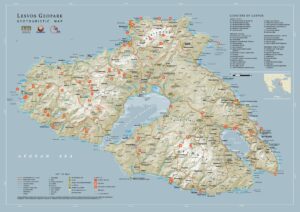
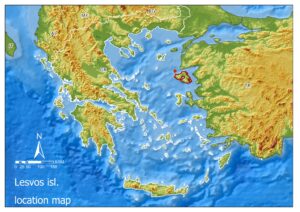
Figure 1. Lesvos Island. A) Geosite map of the Lesvos Island UNESCO Global Geopark. B) Lesvos island location map.
Origin of the Lesvos Petrified Forest
The Petrified Forest exists because of intense volcanic activity in the Northern Aegean during the early Miocene. Lesvos is part of a belt of late Oligocene to middle Miocene calc-alkaline to shoshonitic volcanism of the northern and central Aegean Sea and western Anatolia; Pe-Piper & Piper 2002), and Neogene volcanic rocks dominate the central and western parts of the island.
The main volcanic sequence consists of andesite, dacite, and basalt lavas, ignimbrites, and a thick pyroclastic sequence (Pe-Piper & Piper 2002). In the central part of the island, a series of volcanic centers is located along a SW–NE axis. There are impressive volcanic domes, large dikes, volcanic necks and numerous other volcanic sites. Major craters are located in central Lesvos in the regions of Vatoussa, Agra and Lepetimnos.
The early Miocene volcanic eruptions generated flows of lava, and ash and debris were spewed into the atmosphere, covering extensive areas. The volcanic ash and heavy rainfall following the volcanic eruptions resulted in huge mudflows of pyroclastic material that moved from east to west, covering the dense rich forest that existed on the western part of the island. With considerable speed, these pyroclastic materials covered the trunks, branches, fruits and foliage of the forest trees.
The isolation of the plant tissue from external conditions and intense hydrothermal circulation of fluids rich in silica led to perfect petrification of the plant tissues under optimal conditions. Organic plant material was replaced, molecule by molecule, with the inorganic material of the hydrothermal fluids. Thus, the morphological and anatomical characteristics of the trees such as the external surface, the annual rings and wood internal structures were excellently preserved.
Today, natural erosion of the volcanic rock has revealed impressive standing tree trunks up to 7.2 m tall (Fig. 2). More common are fallen tree trunks measuring up to 25 m in length, with trunk diameters up to 3.5 m. Well-preserved root knots indicate that the forest is autochthonous, and the trees are preserved in their natural locations (Fig. 3), a fact that defines the uniqueness of the Lesvos Petrified Forest.
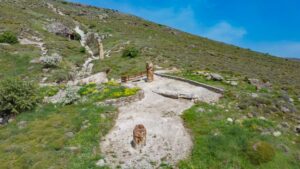
Figure 2. A cluster of standing and lying fossil trees belonging to the Taxodiaceae (Taxodioxylon gypsaceum) at the Lesvos Petrified Forest Park at Bali Alonia.
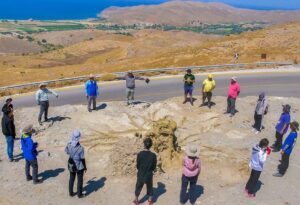
Figure 3. Angiosperm tree trunk with an impressive root system close to Sigri village.
The Flora of the Lesvos Petrified Forest
Systematic research in the Lesvos Petrified Forest started at the end of the 1970s by the paleobotanical research team of the University of Athens (Velitzelos & Symeonides 1978; Velitzelos et al. 1981; Suss & Velitzelos 1997, 1998, 1999, 2000, 2001, 2010; Velitzelos & Zouros 1998; Zouros et al. 2004).
Excavations by the Museum research team since 1997 unearthed a large number of fossils of plants and animals, such as perfectly preserved standing and lying petrified tree trunks, branches, roots, cones, and leaf prints, showing that subtropical forests covered the Aegean landmass during the early Miocene (Velitzelos & Zouros 1998, 2000, 2006).
The lower Miocene forests of Lesvos comprised pteridophytes, conifers, and angiosperms (Table 1), as shown by systematic study of the petrified trunks, leaves, fruits and seeds (Velitzelos & Symeonides 1978; Velitzelos et al. 1981, 2001, Velitzelos 1993; Suss & Velitzelos 1997, 1998, 1999; Velitzelos & Zouros, 1997, 1998, 2000, 2006).
Table 1. Flora of the Petrified Forest of Lesvos (Velitzelos & Zouros 2006)

Conifers are represented by the families Protopinaceae, Pinaceae, Cupressaceae, Taxodiaceae, and Ginkgoales. Many of the fossilized trees belong to the Taxodiaceae (Fig. 4), ancestors of the present-day Sequoia semprevirens, considered the largest plant organism on earth, reaching heights of over 100 m and currently growing on the west coast of the United States. The Protopinaceae are represented by many tree trunks in the Lesvos Petrified Forest Park at Bali Alonia (Fig. 5). Among them, the new pine species Pinoxylon paradoxum Suss & Velitzelos and Pinoxylon pseudoparadoxum Suss & Velitzelos were identified at the park.

Figure 4. Cypress (Tetraklinoxylon velitzelosi SUSS) and Sequoia (Taxodioxylon gypsaceum) cluster in the Lesvos Petrified Forest Park at Bali Alonia.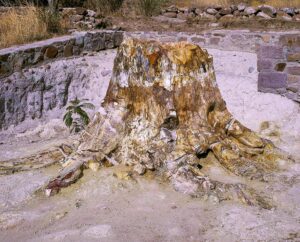
Figure 5. Standing conifer tree with its root system intact, in the Lesvos Petrified Forest Park at Bali Alonia. It belongs to the Pinaceae, and has been described as Pinoxylon paradoxum.
Of the monocotyledons, various types of palms have been identified, while of the broadleaves (dicotyledons) include species of poplar, laurel, cinnamon, plane, oak, lime, beech, alder and maple (Fig. 6). The most common species are Daphnogene polymorpha and Pungiphyllum cruciatum while Phoenix sp. is also common. All of them are represented by a significant number of tree trunks and leaf imprints.
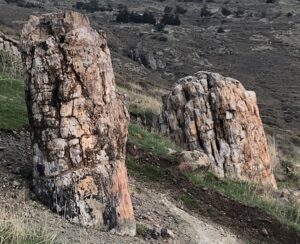
Figure 6. The mixing zone between conifers (Taxodioxylon gypsaceum) and broadleaf trees at the Lesvos Petrified Forest Park at Bali Alonia.
Based on the composition of the palaeoflora, we conclude that during the early Miocene in the Aegean region there were mixed conifer forests with broadleaves and palms at lower elevations. The Petrified Forest developed in a subtropical climate, which changed suddenly to a continental climate, with plants characteristic of the subtropics of Southeast Asia and America.
Animals of the Lesvos Subtropical Forests
In 1999, near the village Gavathas (northwest Lesvos), the lower jaws of the dinotherian proboscidean Prodeinotherium bavaricum were found (Fig. 7). The age of the Lesvos Prodeinotherium, around 19–18.5 million years, makes it the oldest known in the eastern Mediterranean area and marks the first appearance of the deinothere family in Europe, following their migration from Africa where they originated (Koufos et al. 2003).

Figure 7. The lower jaws with the chewing teeth of the deinothere Prodeinotherium bavaricum found in the Lesvos Geopark and exhibited in the Natural History Museum of the Lesvos Petrified Forest in Sigri.
In an area very close to the dinothere fossil locality, near the village Lapsarna, researchers from the Natural History Museum of the Lesvos Petrified Forest discovered, in 2007, a thin layer of sediments with small animal fossils: shells of freshwater snails and terrestrial snails and slugs, pharyngeal teeth and otoliths of freshwater fish (extinct relatives of the modern daces, barbells and kangal fish), bones of small amphibians (salamanders and frogs) and reptiles (snakes and lizards), teeth of crocodiles and teeth and bones of small mammals (bats, hedgehogs, moles, shrews, hamsters and dormice). Their age of about 19 million years means that it is one of the oldest terrestrial faunas known so far from Greece and includes the richest early Miocene gastropod/fish fauna reported up to now from the southern Balkans and the Aegean area (Vasileiadou & Zouros 2012; Vasileiadou et al. 2017).
Excavation and Conservation Work
Since 1997, the Natural History Museum of the Lesvos Petrified Forest has carried out a research programme for the identification and mapping of fοssil locations in the western peninsula of Lesvos island. A variety of fossil locations were found around the Akrocheiras hill range, around Sigri village, in the Tsichliontas river valley, the area of Gavathas and Lapsarna villages, the area north of Tapsas river valley, the area of Skamiouda and the area of Eressos village.
Systematic excavations started in 1997 in the Petrified Forest Park at the Bali Alonia site (Velitzelos and Zouros 1978), located on the southern flanks of Akrocheiras hill range. The excavations aim to reveal the richness of the fossil flora in this historic site, as the majority of the fossil trees were not visible following collection and vandalism of the superficial fossil trees. Another aim of the research is to give to the visitor a sense of the density and variety of trees that made up the forest in the area during the early Miocene. To preserve the finds in their original positions, a geo-conservation project was carried to protect the excavation sites and implement necessary conservation treatment of the fossilized tree trunks.
After 20 years of operation, a major conservation project was carried out at the Petrified Forest Part at “Kyria Apolithomeni” in 2018 and 2019 aiming to conserve the petrified trees, enhance the fossil sites and document the fossilized logs. Conservation was carried out on 50 fossil sites throughout the Park, including the emblematic fossil tree trunks of Taxodiaceae, the most popular exhibits of the Park (Fig. 8). The identification and documentation focused on 120 fossil logs. In parallel, new fossil sites became accessible to visitors and new fossil tree trunks were reconstructed from pieces found during the work. All fossil trees were cleaned and repaired using glue, and aesthetic restoration was applied where necessary. The protective infrastructure of the excavation sites was rearranged to comply with the latest standards regarding the exhibition of fossils in natural sites. Therefore fences, protective walls, and paths were reconstructed.

Figure 8. The tallest standing petrified tree known in Europe, the conifer Taxodioxylon albertense found in the Lesvos Petrified Forest Park at Bali Alonia. Its hight is 7.22 m and its circumference 8.5m.
Systematic excavations took place in 1998 at Sigri, on the western flanks of Veilis hill, close to the Museum. An area of 3 ha was conceded to the Museum by the Greek state to protect the fossils and create a new visit site that presents a variety of standing petrified tree trunks with their root systems intact in their original positions. The majority of trees belong to the Pinaceae. At the same site, a pyroclastic horizon very rich in pine needles and pine-cones trapped in layers of volcanic ash was found. There are several other standing trees whose wood is not well enough preserved for identification of the species. For the protection and preservation of the fossils, the site was fenced, and the Sigri Petrified Forest Park was established.
Mapping and geophysical research on the Plaka peninsula identified a large number of fossil sites. The area of 7.5 ha was conceded to the Museum in 2000 and systematic excavations started in 2001. A large number of clusters of petrified trees have been found in 45 fossil sites. Among them is the largest standing petrified tree trunk with a perimeter of 13.7 m, belonging to the Lauraceae. The 13.5 m long tree trunk of an angiosperm tree lies along the coast (Fig. 9). Paleobotanical study has identified Several tree trunks and root knots as belonging to conifers (Pinoxylon paradoxum, Pinoxylon sp., Pinus sp.), dicotyledons (Laurinoxylon sp., Populoxylon sp.) and monocotylidons (Phoenix sp.). The Plaka Petrified Forest Park opened to the public after the completion of protection and conservation works. These include protective shelters, stone walls and wooden fences along the pathways and conservation treatment on all excavated fossil trees.
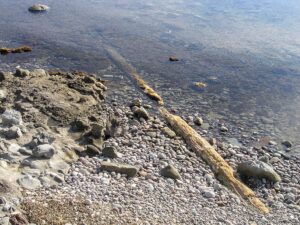
Figure 9. Lying petrified tree trunk of an angiosperm tree in Plaka park.
Systematic excavations carried out on Nisiopi islet during 2013–2015 revealed 250 standing and lying tree trunks, belonging to conifers and broadleaf trees, from 44 fossil sites. Erosion uncovered the fossils lying in the upper stratigraphic horizons of the pyroclastic sequence. Many branches and twigs as well as root systems of trees were found, together with leaf horizons. The majority of fossils belong to Pinaceae and Taxodiaceae as well as to the Lauraceae, Fagaceae and Junglandaceae. A new species was found in Nissiopi, Taxodioxylon megalonissium identified by Prof. E. Velitzelos. Along the coastal cliffs of Nissiopi are several successive horizons of volcanic ash layers, flow tuffs, mud flow deposits and stream conglomerate. In many sites fossil-bearing layers are visible, representing successive volcanic eruptions that destroyed the vegetation. Intense tectonic activity and rising sea levels in the Aegean left standing and lying tree trunks in the marine area around the coastline of Nissiopi islet.
In the last two decades, many fossil sites were unearthed in the Petrified Forest area by rescue excavations during the construction of important public works. The first took place in Skamiouda hill close to Antissa with the construction of the Skaniouda windmill park, the second in the area south of Plaka park with the construction of the Sigri biological wastewater treatment station, the third at the top of Akrocheiras hill with the reconstruction of the Akrocheiras windmill park and the biggest with the construction of the Sigri–Antissa road, the main road crossing the protected area of the Petrified Forest.
An example was the rescue excavations carried out by the Natural History Museum of the Lesvos Petrified Forest at the top Akrocheiras hill as part of a project for the replacement of the windmills at the Akrocheiras Wind Mill Park by the National Electricity Company. Hundreds of fossil trees were revealed in foundation areas of the windmills during 2018–2019. Most of the horizontal trees had been buried by mega-mud flows, including the largest fossilized tree ever discovered in the Lesvos Petrified Forest. The majority of the finds after conservation treatment were moved to the Museum to allow the construction of the wind farm, while the most prominent ones were preserved in situ. The impressive gigantic lying fossil trunks of sequoia trees, almost 25 m long (Fig. 10), will be the main exhibits of the new open-air park which will be created on Akrocheiras hill.
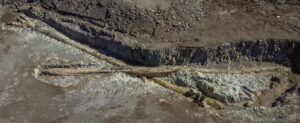
Figure 10. Impressive lying sequoia tree trunks 25 m long at Akrocheiras park fossil site.
The largest rescue excavation project started in 2013 along the Kalloni–Sigri highway and is still ongoing. This rescue excavation revealed more than 10,000 specimens, including fossil tree trunks, branches, root systems, leaves and fruits. More than 15 significant fossil sites were excavated along the 20 km highway. The majority of fossils will remain in their original place, creating a new open-air museum, and thousands of new specimens of fossil tree trunks and leaves were moved to the Museum.
During the last months, two new significant fossil sites have been excavated on Ackrocheiras hill, close to Sigri village. These have yielded impressive finds. The first site revealed a unique petrified tree trunk, 19.4 m long, with its branches and roots still intact, lying on a layer of volcanic ash full of leaves and small branches (Fig. 11). The second site revealed more than 150 fossilized tree trunks on overlapping horizons. The trunks of the trees were broken and carried away like matchboxes by the violence of the volcanic eruption gases and ash that covered the vegetation over a large area. Heavy rains then caused widespread flooding throughout the area, creating large amounts of mud that swept away volcanic ash along with volcanic fireballs and broken tree trunks.
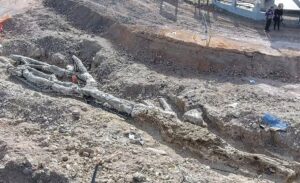
Figure 11. A new find in Lesvos of an angiosperm tree 19.5 m long, found intact with its branches and roots lying on an ash layer.
Geoconservation Strategy
The Lesvos Petrified Forest protected area comprises 15,000 ha, but important fossil sites occur over all the volcanic terrains, covering about 900 km2. The Petrified Forest is the main element of geological heritage of international significance for the nomination of Lesvos Island as a UNESCO Global Geopark. Geosites are essential elements of the Lesvos Geopark, providing information to visitors about the importance of the geological and geomorphological processes that shaped the landscape.
A geoconservation plan aiming at sustainable development of the Petrified Forest area was executed in 1996, including research, excavation, protection and conservation activities within the protected area. The geoconservation plan was updated in 2000 to link the fossil plant sites with a variety of volcanic geosites related to the creation of the Lesvos Petrified Forest. The main aim of the plan was to achieve effective protection and preservation of the Petrified Forest through its enhancement and promotion, the integration of geoheritage protection in environmental education, and the development of geotourism.
A strategic geoconservation plan for the whole of Lesvos Island was adopted in 2011, after the decision to extend the area and activities of the Geopark. This plan takes into consideration the results of research and excavations in the Petrified Forest area, the identification of important geosites (i.e., volcanic structures, domes, craters, thermal springs, tectonic structures, coastal geosites, and erosional structures), and the presence of important ecosystems and cultural resources. This plan aims for further development of the Geopark infrastructure, spot interventions and infrastructures as well as the development of educational and geotouristic activities.
The Natural History Museum of the Lesvos Petrified Forest carries out geoconservation activities for the protection, conservation and promotion of the Petrified Forest. These measures comprise: 1) regular maintenance (fencing, cleaning) and janitor services to protect geosites against abuse and vandalism; 2) geosite monitoring providing the necessary measures and protective installations against weathering and erosion; 3) fossil site conservation and preservation projects, treatment of vulnerable geosites with annual conservation and protective measures (preparation, sealing); 4) interpretation of geosites with onsite information panels, leaflets and field guides; and 5) organization of on-site activities (education programs, guided trekking on geosite trails, various recreation activities in the vicinity of geosites, etc.). All the above-mentioned activities contribute to raising public awareness of the value and importance of the geological heritage of Lesvos Island.
Protection and Management
Lesvos Petrified Forest is the main geological heritage site of international significance in the Lesvos Geopark. The Lesvos Island UNESCO Global Geopark integrates the range of resources, including the petrified forest open air parks created at important fossil sites, the Bali Alonia–Kyria Apolithomeni park, the Sigri park, the Plaka park and the Nisiopi islet park, the various interpreted geosites, enchanting landscapes, wetlands, sites of natural beauty and ecological value, as well as museums, archeological sites, cultural monuments, picturesque villages, local traditions and gastronomy as well as local products.
The Petrified Forest Park at Bali Alonia site, also called “Kyria Apolithomeni”, with a total area of 28.6 ha, is a unique experience. Visitors are astounded by the host of perfectly preserved fossilized trees, making up a whole forest ecosystem from the distant past. Nowhere else on the planet are there so many standing fossilized trunks. Visitors are struck by the exceedingly complex color combinations with which nature has adorned the petrified trees, and marvel at the authenticity of the fossilized trunks, which have retained the tiniest detail of their interiors. Visitors are impressed by the number and dimensions of the dozens of standing and fallen trunks; these are scattered over the area and are sometimes more than 7 m in height and 22 m long. The biggest is 7.02 m in height and is the tallest standing petrified tree in Europe.
The Sigri park, covering an area of 2 ha, is on a fossil site located adjacent to the Petrified Forest Museum and contains clusters of conifer petrified trees with their root systems intact, still in their original position. The park also hosts a unique fossil site, an ash layer with pine cones and needles.
The Plaka Park, 800 m south of Sigri village, covers an area of 7 ha. There the visitor can admire impressive petrified tree trunks, unique fossilized leaves and of course the thickest standing tree trunk in the world, with a perimeter of 13.7 m. From Sigri port, tourists can visit by boat the picturesque Megalonisi or Nisiopi islet, where they can enjoy the spectacle of very fine coastal and marine sections of the Petrified Forest. The Nissiopi marine Petrified Forest Park shows fossilized trunks of angiosperms and conifers with a great variety of colors on the islet’s west coast. 44 fossil sites are located along the trail walking path on Nisiopi islet, including a giant sequoia tree trunk, more than 10 m long.
A broad range of activities makes up the main components for the operation of Lesvos Geopark, including scientific research, the creation of the geosite inventory and map, the protection, interpretation and promotion of geosites, the conservation of fossils, the creation of visiting parks, the establishment of a network of walking trails linking geosites to ecotourism infrastructures, the development of environmental education programs on geosites, the organization of scientific and cultural events, and the promotion of monumental geosites.
The effort to highlight, interpret and present to the visitors the geological monuments of Lesvos Island resulted in the creation of a network of geo-routes - a tour of geological time and the geohistorical evolution of the Aegean - that connect the geological environment with the appearance of humans in Lesvos and the landscapes and natural resources of Lesvos Island with the dawn of Aegean civilization.
Schools and universities from Greece, Europe and Asia are attracted to Lesvos Geopark by the educational programs, outdoor experience programs, field courses, volunteer workshops and activities . At the same time, the Lesvos Geopark develops synergies with the Museums of Lesvos, the Chamber of Lesvos, tourist and productive organizations, associations and unions, with the aim of providing information to visitors and promoting the natural and cultural wealth of Lesvos. Long-term cooperation has also been developed with women’s agritourism cooperatives, craftsmen and local producers to promote local products and create events, such as the "Earth Feast" summer cultural festival and the agritourism festival.
Conclusions
The Lesvos Petrified Forest is a unique geological and paleontological site and constitutes the most important element of international significance for the Lesvos Island UNESCO Global Geopark. Scientific research as well as systematic and rescue excavations, conservation programmes, interpretation and educational activities carried out during the last 25 years contributed significantly to the enhancement, promotion and international recognition of the protected natural monument
Lesvos Geopark integrates various natural and cultural resources, including the existing geological wonders the Petrified Forest, various interpreted geosites, unique landscapes, wetlands, sites of natural beauty and ecological value, as well as cultural monuments, picturesque villages, traditional gastronomy, and local products as well as the Natural History Museum of the Lesvos Petrified Forest, the Kalloni Environmental Interpretation Center, the Mytilene Information Center, the network of cooperating Museums and collections. These engage in a broad range of activities, including scientific research; creation of the geosite inventory and map; protection, interpretation, and promotion of geosites; conservation of fossils; creation of open-air parks; establishment of a network of walking trails linking geosites to ecotourism facilities; development of environmental education programs on geosites; organization of scientific and cultural events; and promotion of geosite monuments.
The results achieved by Lesvos Geopark demonstrate the potential of all geoparks across Europe to be powerful new tools for holistic nature conservation and sustainable rural development.
